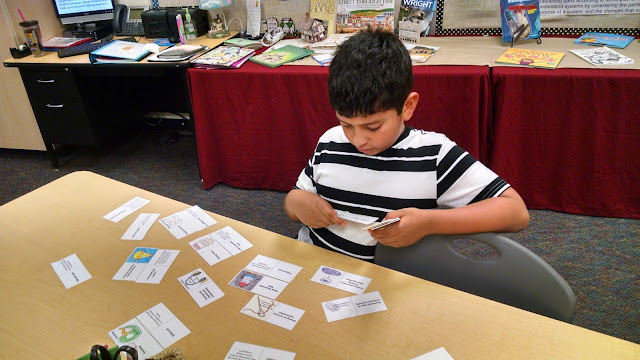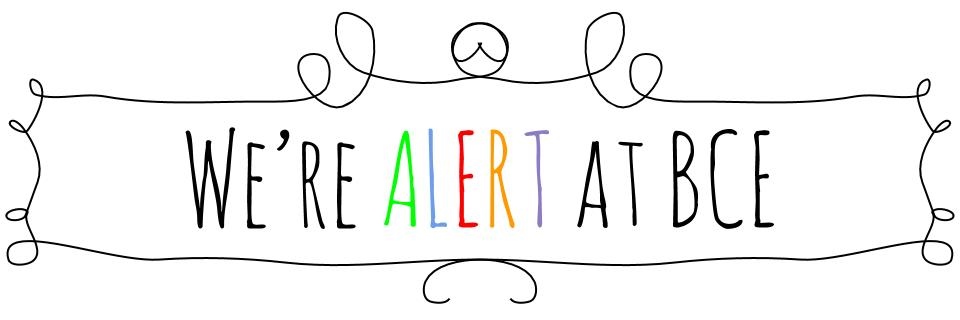We had our commencing Digging for Data math lesson and students looked at both their rights and obligations as we embark. This math curriculum focuses heavily on discussion, defense of one's thinking, and writing about concepts. Today, students collected data on their jumping rate. Each student completed three trials counting the number of jumps they could complete in one minute. We used this data to understand the concept of the median in a set of numbers and how if can be used when looking for a "typical" result in a set of output data.
We also did our daily morphic thinking to build fluency and originality of ideas and learned some at home techniques for dusting for fingerprints. Next week we will check the prints we uncovered with our suspect samples to determine the culprit in The Case of the Sugar Shaker!
Thursday, September 24, 2015
Thursday, September 17, 2015
Systems Kick-off!
Our favorite activity of the day was kicking off our year-long theme of Systems. Students interpreted the definition of a system and worked in teams to brainstorm examples. They came up with some great ones! We also named the different features of systems, (boundary, input, output, elements, & interactions) drew and labeled the parts of a system, created a list of generalizations about systems, and competed in a friendly Kahoot quiz to show off what we had learned.
Generalization for Systems:
We also explored some creative thinking activities on Renzulli, did our daily morphic thinking, and practiced building a growth mindset by persisting in some brain challenges with the Set and Quiddler daily puzzles and word analogies.
Generalization for Systems:
- Systems have parts that work together to create a whole.
- Systems interact.
- Parts of systems are interdependent upon one another.
- A system may be influenced by another system.
 |
| Systems illustrations and labels |
We also explored some creative thinking activities on Renzulli, did our daily morphic thinking, and practiced building a growth mindset by persisting in some brain challenges with the Set and Quiddler daily puzzles and word analogies.
 |
| Renzulli Learning |
Thursday, September 10, 2015
The Brain and Mindset
This week we focused on meta-cognition. (Thinking about our thinking!)
We kicked off our Morphic Thinking morning routine where students warm-up with a spontaneous problem and boundary breaker. We will be including these weekly.
Spontaneous Problem: A spontaneous problem is a brainstorming type problem to be solved in a specific amount of time and scored according to the number and creativity of responses generated. The point is to challenge students to be flexible thinkers, to elaborate on original ideas and to think fluently and creatively about a specific topic.
Today's Spontaneous Problem: Name things in the ALERT room.
Boundary Breaker: A boundary breaker is a group experience which works toward creating a sense of community. Students gain an awareness of and respect for the opinion of others by the use of questions that go beyond superficial depth and have no right/wrong answers. Boundary Breakers also provoke a higher level of thought that merges cognitive and affective thinking.
Today's Boundary Breaker: What is thinking? Why is thinking important?
Carrying on with the same theme, students learned about the connections they make in their brain when they learn and how to strengthen these pathways. They were able to draw their conception of their brain, feel a brain, and use various resources to discover the parts of the brain and how they work together for your body to function. This year we want to be very intentional about building a growth mindset in students. It will be our goal to emphasize the part of effort and perseverance in learning and intelligence as something that can be grown or grow stagnant. To evaluate our current perspective on intelligence, we took the mindset quiz at this link. Feel free to take it yourself! We want to turn "I can't do it!" into "I can't do it yet!"
We also took a pre-assessment for our upcoming math unit, solved the mystery of the Rubber Band Jar, and looked at critical thinking and different types of thinkers. Ask you child about Naive Nancy, Selfish Sam, and Fair-minded Fran. Students should recognize quality thinking as accurate, fair, clear, relevant, and logical.
We kicked off our Morphic Thinking morning routine where students warm-up with a spontaneous problem and boundary breaker. We will be including these weekly.
Spontaneous Problem: A spontaneous problem is a brainstorming type problem to be solved in a specific amount of time and scored according to the number and creativity of responses generated. The point is to challenge students to be flexible thinkers, to elaborate on original ideas and to think fluently and creatively about a specific topic.
Today's Spontaneous Problem: Name things in the ALERT room.
Boundary Breaker: A boundary breaker is a group experience which works toward creating a sense of community. Students gain an awareness of and respect for the opinion of others by the use of questions that go beyond superficial depth and have no right/wrong answers. Boundary Breakers also provoke a higher level of thought that merges cognitive and affective thinking.
Today's Boundary Breaker: What is thinking? Why is thinking important?
Carrying on with the same theme, students learned about the connections they make in their brain when they learn and how to strengthen these pathways. They were able to draw their conception of their brain, feel a brain, and use various resources to discover the parts of the brain and how they work together for your body to function. This year we want to be very intentional about building a growth mindset in students. It will be our goal to emphasize the part of effort and perseverance in learning and intelligence as something that can be grown or grow stagnant. To evaluate our current perspective on intelligence, we took the mindset quiz at this link. Feel free to take it yourself! We want to turn "I can't do it!" into "I can't do it yet!"
 |
| Touching a "brain"! |
 |
| Touching a "brain". |
 |
| Showing the difference between strong neural pathways and weak ones. |
We also took a pre-assessment for our upcoming math unit, solved the mystery of the Rubber Band Jar, and looked at critical thinking and different types of thinkers. Ask you child about Naive Nancy, Selfish Sam, and Fair-minded Fran. Students should recognize quality thinking as accurate, fair, clear, relevant, and logical.
Thursday, September 3, 2015
NERDS!
It's great to be back for our second week! This week we explored our creative side by discussing and demonstrating the four keys to creative thinking. We began by taking a simple figure, looking at it from various perspectives (flexible thinking), brainstorming what it could become (fluency of ideas), choosing the idea like no one else's (originality), and filling in the details of our picture (elaboration)! Our lesson was themed around our mascots of creativity the NERDS candies which the students got to enjoy while they worked. I loved one student's response as we discussed the being creative, "That reminds me of a joke I made up...What did one unicorn say to the other unicorn? You are uni-que!" Adorable! These creative pieces became the covers of our ALERT binders reminding us to "think outside the box"!

Our other main focus for the day was looking into Art Costa's Habits of Mind. We discussed these strategies of successful people and discussed ways we do and will use them this year inside and outside our classroom. Student team completed in a pre and post lesson matching game where every pair came out on top improving their understanding of the ideas.


Other happenings were the creating of a class fingerprint archive just in case we need it for future suspects in future tomfoolery, putting the finishing touches on our writer's notebooks, and getting started on our learner profiles at RenzulliLearning.com.
I hope your student enjoyed today. I did! (We missed you, Cameron!)

Our other main focus for the day was looking into Art Costa's Habits of Mind. We discussed these strategies of successful people and discussed ways we do and will use them this year inside and outside our classroom. Student team completed in a pre and post lesson matching game where every pair came out on top improving their understanding of the ideas.


Other happenings were the creating of a class fingerprint archive just in case we need it for future suspects in future tomfoolery, putting the finishing touches on our writer's notebooks, and getting started on our learner profiles at RenzulliLearning.com.
I hope your student enjoyed today. I did! (We missed you, Cameron!)
Subscribe to:
Posts (Atom)






